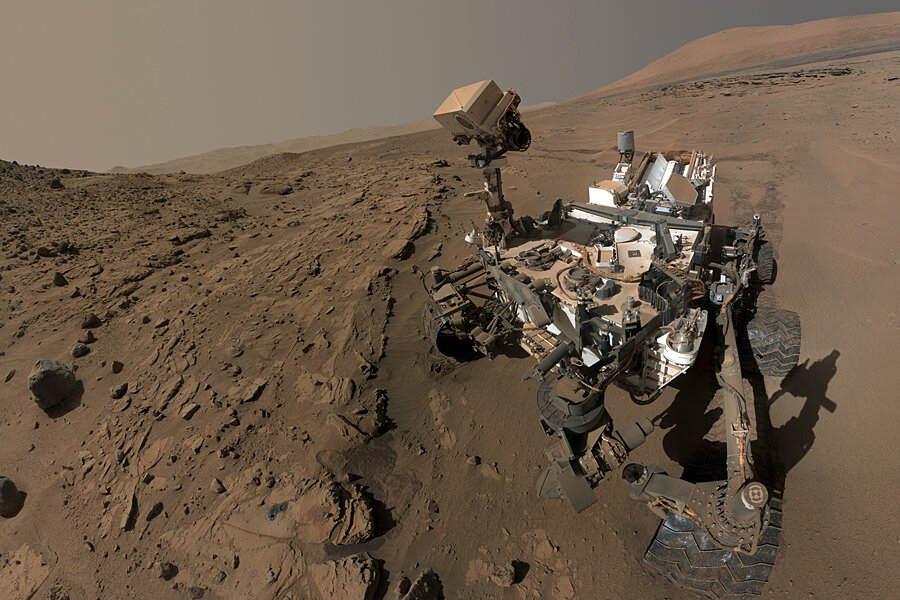Mars rover Curiosity reaches ultimate destination: Mt. Sharp
Loading...
Two years and several remarkable discoveries after it first landed on Mars, NASA's rover Curiosity has finally reached its ultimate destination inside Gale Crater: Mt. Sharp.
Formally known as Aeolis Mons, the mountain vaults, layer by sediment layer, to some 18,000 feet above the crater's northern floor. The lower layers, in particular, are of keen interest because they were deposited on what could have been an ancient lake bed.
"We have finally arrived at the far frontier we have sought for so long," said John Grotzinger, the mission's project scientist, during a briefing on Thursday.
Initially, Curiosity was to have landed, tested its instruments locally, then headed for the mountain.
But data from Mars orbiters indicated that interesting geology lay on the surface not far from the rover's landing spot, at a formation the team named Yellowknife Bay. The formation, it was thought, might have some bearing on answering the mission's basic question: Could the area have supported microbial life?
The path to Yellowknife Bay took Curiosity away from the mountain – and it hit pay dirt.
Data that Curiosity gathered there within the rover's first 100 Martian days, or sols, revealed the existence of an ancient lake. But water alone does not a habitat make. Geochemical evidence that the rover gathered yielded other indications that the environment at the time would have rendered the area quite comfy for microbial life.
The research team had the answer to the basic question that Curiosity was designed to address, and the rover hadn't even struck out for the base of the mountain yet, about 2-1/2 miles away.
But another of the mission's objectives is to hunt for organic compounds, which might serve as signals that life actually could have gained a foothold in the crater. At the least, the presence of these compounds would be yet another indicator of the crater's hospitality. The best places to look for those, the team reasoned, were in the layered outcroppings on the lower slopes of Mt. Sharp. There, hopefully within range of the rover's drill, organics might be locked up in the rocks, protected from the ravages of high levels of the sun's ultraviolet radiation reaching the surface.
Now, within two weeks, the team hopes to begin drilling into rock formations in Hidden Valley, part of an area they've called the Pahrump Hills. Curiosity's camera has spotted thin outcrops poking through the sediment on the valley floor.
"We see lots of interesting features there that suggest strongly that these rocks were formed in the presence of water. We're every excited by this," Dr. Grotzinger said.
As Curiosity approached, it found rocks that have the look of irregular-shaped flagstones set into the Martian soil. One of these greenish-gray, plate-like rocks has fractures filled with a light substance that the team suspects is a sulfate mineral. The plate-like rock is very reminiscent of rocks the team found at Yellowknife Bay, he said.
In an engineering test, the team had Curiosity drill into the rock, dubbed Bonanza King. The rock proved too unstable to drill into further, but the researchers identified high levels of silica in it – higher than any other rocks studied on the planet except for rocks that the rover Spirit found at Columbia Hills.
The team hasn't seen this in rocks it has studied so far in Gale Crater, meaning that the researchers "are on to something new," Grotzinger said. "We're optimistic that we are going to be able to talk about a science story in the next few months that will be one that involves water."
Given the goal of looking for organics on the mountain's lower slopes, evidence that water was present there as well could provide on-the-ground evidence that the team has picked the right hunting grounds.
Eventually, Curiosity will work its way up slope through formations that the team has dubbed Murray Buttes and on to Hematite Ridge, where layering in the sediments is much more distinct than it is among the buttes.
Based on data from orbiters, the ridge also represents a significant shift in mineral composition within the layers.
The "burning question" this transition raises is whether the physical and mineralogical changes "represent changes in habitability in Gale Crater over time," said Kathryn Stack, a researcher at NASA's Jet Propulsion Laboratory in Pasadena, Calif., and Curiosity's mission scientist.







